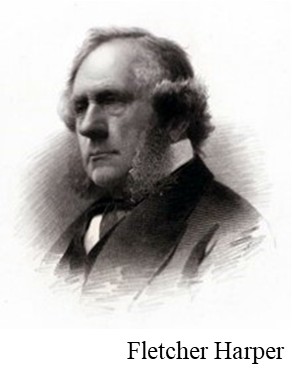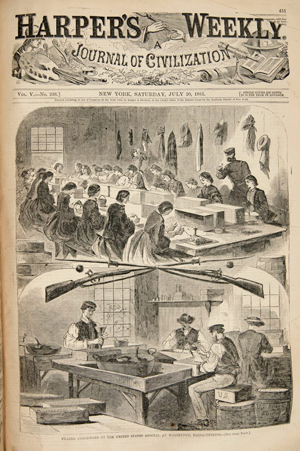
The President’s Message:
I hope that everyone got through the extremely hot summer that we had in
Florida. Our next meeting
will be on Wednesday, October 8th
at 7:00PM at the Lake Clarke Shores Town Hall.
Our topic will be “Would You Enlist in the Army During the Civil
War.” I look forward to
seeing everyone at the meeting.
Gerridine LaRovere
October 3, 2025
Topic:
The last meeting we had was on June 11, 2025.
The newsletter from that meeting is on the website.
Because it was not possible to fit that into a
three page printed document and include this new material, this
short newsletter is being published instead.
The following story was put together by Gerridine.
 In
1857, Fletcher Harper, of Harper and Brother Publishing, launched
Harper’s Weekly.
It was an illustrated newspaper that sold for five cents a copy,
and capitalized on the popularity of illustrated newspapers that
originated in England. The
public saw woodcut engravings of news events in the age before printing
photographs was available.
The newspaper was published each Saturday, had a national circulation
and borrowed from the successful format of the well-established
Harper’s Monthly Magazine.
Serialized novels by popular contemporary authors such as Charles
Dickens and Wilkie Collins were featured.
Collins was an English author.
His books
The Woman in
White
and
The Moonstone
established many of the ground rules of the modern detective novel and
procedural detective stories. In
1857, Fletcher Harper, of Harper and Brother Publishing, launched
Harper’s Weekly.
It was an illustrated newspaper that sold for five cents a copy,
and capitalized on the popularity of illustrated newspapers that
originated in England. The
public saw woodcut engravings of news events in the age before printing
photographs was available.
The newspaper was published each Saturday, had a national circulation
and borrowed from the successful format of the well-established
Harper’s Monthly Magazine.
Serialized novels by popular contemporary authors such as Charles
Dickens and Wilkie Collins were featured.
Collins was an English author.
His books
The Woman in
White
and
The Moonstone
established many of the ground rules of the modern detective novel and
procedural detective stories.
At Fletcher Harper’s direction the newspaper, now selling at an inflated
wartime price of six cents an issue, kept an unflagging, pro-Union,
pro-war policy throughout the Civil War.
Through its graphics, most Federal servicemen were depicted as
noble martyrs and heroes and most Confederates as flea-bitten villains.
The newspaper served as propaganda for the Union cause.
The paper featured cartoons and jokes that were extremely racist
and ethnocentric by today’s standards.
In 1862, George William Curtis became the editor.
He was a writer, reformer, speaker, and civil rights supporter.
Harper’s Weekly
contributed to the history of the Civil War with its art.
News artist Alfred R .
Waud, Henry Mosler, and Theodore Davis aided in building
Harper’s
reputation for graphic art. News artist, Winslow Homer, won personal
recognition for his fine art.
Thomas Nast who later joined the newspaper brought the paper
national note for his caricatures of corrupt New York City Mayor William
Marcy “Boss” Tweed. A
two-page spread published in 1862 depicted Confederate defenses at
Yorktown, Virginia and giving the location, strength, and position of
Union units caused a problem with the Federal government.
Union Secretary of War Edwin M. Stanton who was an advocate of
censorship ordered the publication of the newspaper totally suspended.
Fletcher Harper used his diplomatic skills to reverse the order. .
Waud, Henry Mosler, and Theodore Davis aided in building
Harper’s
reputation for graphic art. News artist, Winslow Homer, won personal
recognition for his fine art.
Thomas Nast who later joined the newspaper brought the paper
national note for his caricatures of corrupt New York City Mayor William
Marcy “Boss” Tweed. A
two-page spread published in 1862 depicted Confederate defenses at
Yorktown, Virginia and giving the location, strength, and position of
Union units caused a problem with the Federal government.
Union Secretary of War Edwin M. Stanton who was an advocate of
censorship ordered the publication of the newspaper totally suspended.
Fletcher Harper used his diplomatic skills to reverse the order.
The paper’s popularity eclipsed its nearest rival, Frank Leslie’s
Illustrated Newspaper.
The paper had growth until the 1870’s.
With the advent of photography, people’s taste changed.
In 1916, the newspaper was absorbed by a publication called
The Independent.
Last changed: 10/03/25 |

